全文HTML
--> --> -->超冷原子实验装置的微型化一直受到传统光学元件(如反射镜、透镜、分束器等)的尺寸所约束. 超表面可以对入射光场进行多自由度精确调控, 相比较于由微结构金属线和磁性薄膜构成的原子芯片来说, 超表面光学原子芯片可以为发展下一代基于超冷原子及其量子态片上实验平台提供新方法和新思路, 具有重要的应用前景[13-16]. 为了达到光学系统体积小和功耗降低的目的, 几种基于超表面的微型原子磁光阱(magneto-optical trap, MOT)方案被报道[17-22]. 英国Arnold小组最早采用超表面光栅结构来研究反射式原子MOT, 2013年他们报道了超表面光栅原子MOT实验, 对于圆形光栅结构, 可以囚禁6 × 107个铷原子[17]. 2020年, 南方科技大学李贵新小组[20]也报道了超表面透射式原子MOT的方案, 一束左旋圆偏振激光透过原子光学芯片被分为五束右旋圆偏振态可控的光束, 将所有反射光束在四极磁场的中心相交, 形成了一单束原子MOT, 捕获的铷原子数为107个, 原子温度约35 μK. 超表面原子MOT可以应用于便携式的冷原子钟[22]. 最近, 笔者课题组[23,24]也提出了利用超透镜的会聚光场来实现MgF分子的光学囚禁的方案. 综上所述, 目前的超透镜都是将反射光束或者透射光束会聚到一个焦点上, 对于在其焦平面上形成一个聚焦光环的方案还没有报道. 聚焦光环可以构建适用于冷分子囚禁的光学储存环, 囚禁在储存环内的分子可以与激光场或者分子之间不断地相互作用, 因此分子储存环给冷碰撞提供了很好的实验平台. 与电场或磁场的储存环(原子芯片)相比, 纯光学储存环不需要考虑分子的极性(电偶极矩)和顺磁性(磁偶极矩)等特性, 任何分子都可以进行光学囚禁[25,26].
本文提出了一种超透镜结构, 在焦平面上可形成聚焦光环. 首先, 介绍了这种超透镜的设计原理, 研究了在焦平面上环形光场的强度分布和有不同数值孔径的超透镜的聚焦特性. 其次, 采用超透镜聚焦光环来构建一个MgF分子的光学存储环, 计算了MgF分子在聚焦光场中所受的光学势和偶极力, 采用Monte-Carlo模拟方法对存储环中MgF分子的运动动力学过程进行了研究.
2.1.周期性单元结构的设计
超表面对电磁波的相位调控分为以下几种方式: 传输型相位、几何型相位、电路型相位等. 本文主要应用传输型相位来设计超表面存储环, 电磁波通过在传输过程中产生的光程差来实现相位调控, 用公式可以表示为图1(a)展示了本文设计的超构表面所应用的周期性结构单元, 其衬底采用SiO2材料, 上面生长Si材料微结构. SiO2衬底的晶格周期宽度设为P, 上面的Si柱宽度设为W, 高度设为H. 改变晶格单元上的Si柱的结构即可调控超表面该位置的有效折射率neff, 进而实现对入射光波前相位的调控. 要实现波导效应, Si柱高度需要满足一定的条件使其对相位的调控覆盖2π的相位范围. 入射光波长为1064 nm, 硅柱高度需要半个波长左右, 经过仿真扫描不同范围的结构参数, 把高度H设置为480 nm. 图1(b)和1(c)给出了晶格宽度P和硅柱宽度W分别与透射率之间的变化规律. 纵坐标为占空比, 定义为硅柱宽度W与晶格宽度P的比值, 即占空比(duty cycle) = W/P. 仿真模拟采用时域有限差分法(finite difference time domain, FDTD)进行扫描.
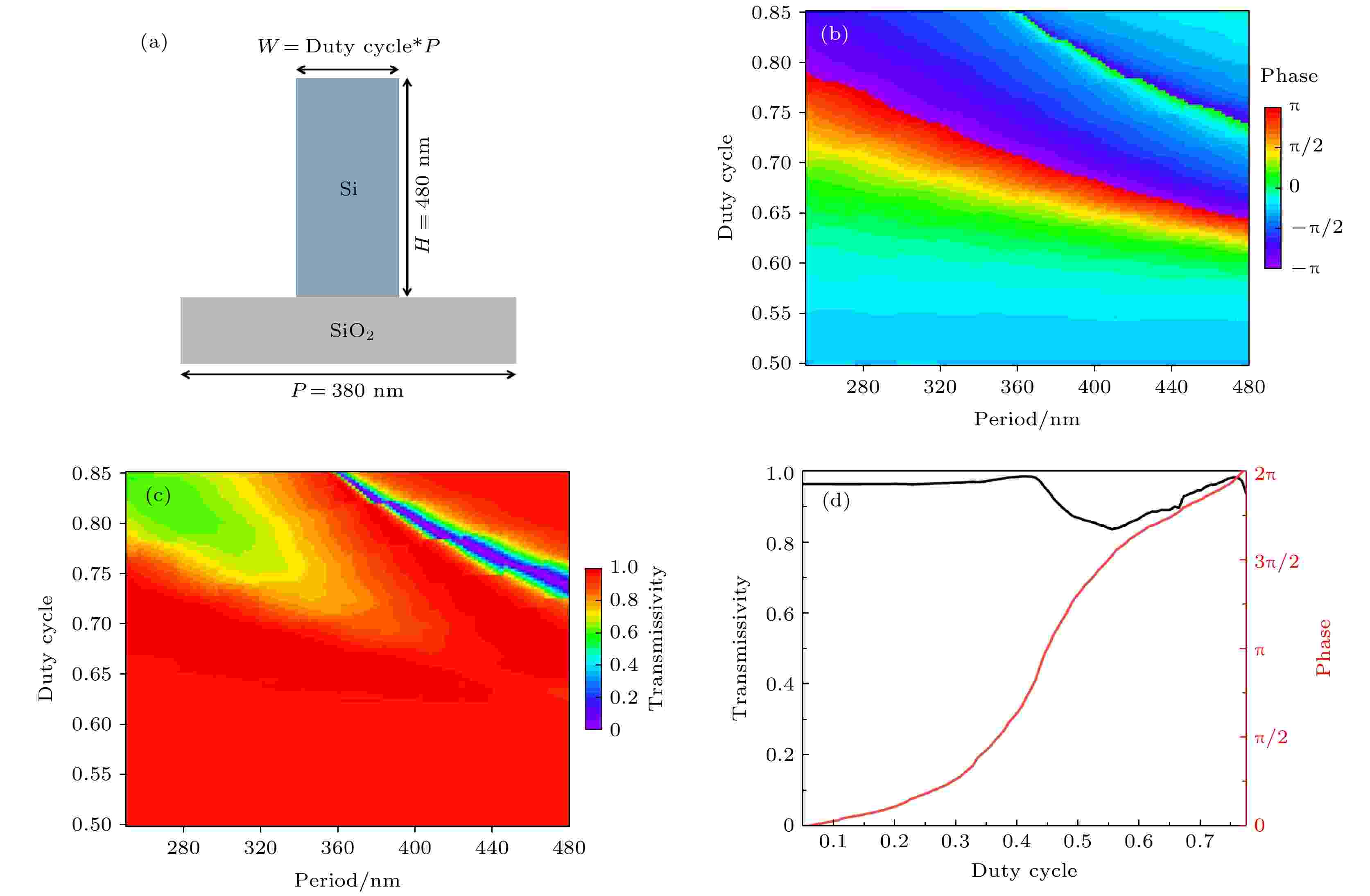 图 1 (a)单元结构的示意图, Si柱宽度为W, 高度为H, SiO2基底的在周期为P; (b)和(c)分别表示扫描单元衬底周期和占空比得到的相位、透射率二维图; (d)当P = 380 nm时, 相位和透射率分别与占空比之间的关系, 黑色实线为透射率曲线, 红色实线为相位变化曲线
图 1 (a)单元结构的示意图, Si柱宽度为W, 高度为H, SiO2基底的在周期为P; (b)和(c)分别表示扫描单元衬底周期和占空比得到的相位、透射率二维图; (d)当P = 380 nm时, 相位和透射率分别与占空比之间的关系, 黑色实线为透射率曲线, 红色实线为相位变化曲线Figure1. (a) Schematic diagram of the unit structure, the width of the Si column is W, the height is H, and the period of the SiO2 substrate is P; (b) and (c) represent the two-dimensional diagram of the phase and transmittance obtained by scanning the period and duty cycle of the unit structure, respectively; (d) when P = 380 nm, the dependence of the phase and transmittance on the duty cycle, respectively, the black solid line is the transmittance curve, and the red solid line is the phase change curve.
为了设计超平面环形透镜, 单元结构对于相位的调控不仅要覆盖2π相位范围, 而且还要具有高透射率. 从图1(b)中可以看出, 当占空比从0.05变化到0.8, 图中周期P大于340 nm区域的颜色变化范围覆盖了全色域, 即选择这个区域的结构参数可实现对于相位调控0—2π范围的全覆盖, 同时满足图1(c)中接近红色的高透射率区域即可完成对于周期P的筛选. 最后把周期P = 380 nm作为一个优化的选择, 改变硅柱宽度W的仿真结果如图1(d)所示, 红线表示当光栅的占空比从0.05变化到0.75, 相位覆盖了2π的范围, 黑线表示占空比变化的时单元结构保持着大于80%的透射率. 这样确定了周期性单元晶格的结构参数: P = 380 nm, H = 480 nm, 占空比范围在0.05—0.76, 用于调控传输相位.
2
2.2.超表面储存环的设计
超表面光学储存环设计本质上就是在芯片表面形成环形光场, 也就是设计超表面环形透镜, 如图2(a)所示. 光束入射到平面环形透镜, 在其焦平面上形成聚焦的光环. 设计原理是在一条半径方向上的光栅阵列的相位排布能将入射光会聚到焦平面, 这样的一维光栅阵列结构旋转一圈扩展成二维光栅圆环阵列就能将径向入射光在每个半径方向上汇聚至焦平面, 最终形成聚焦光环.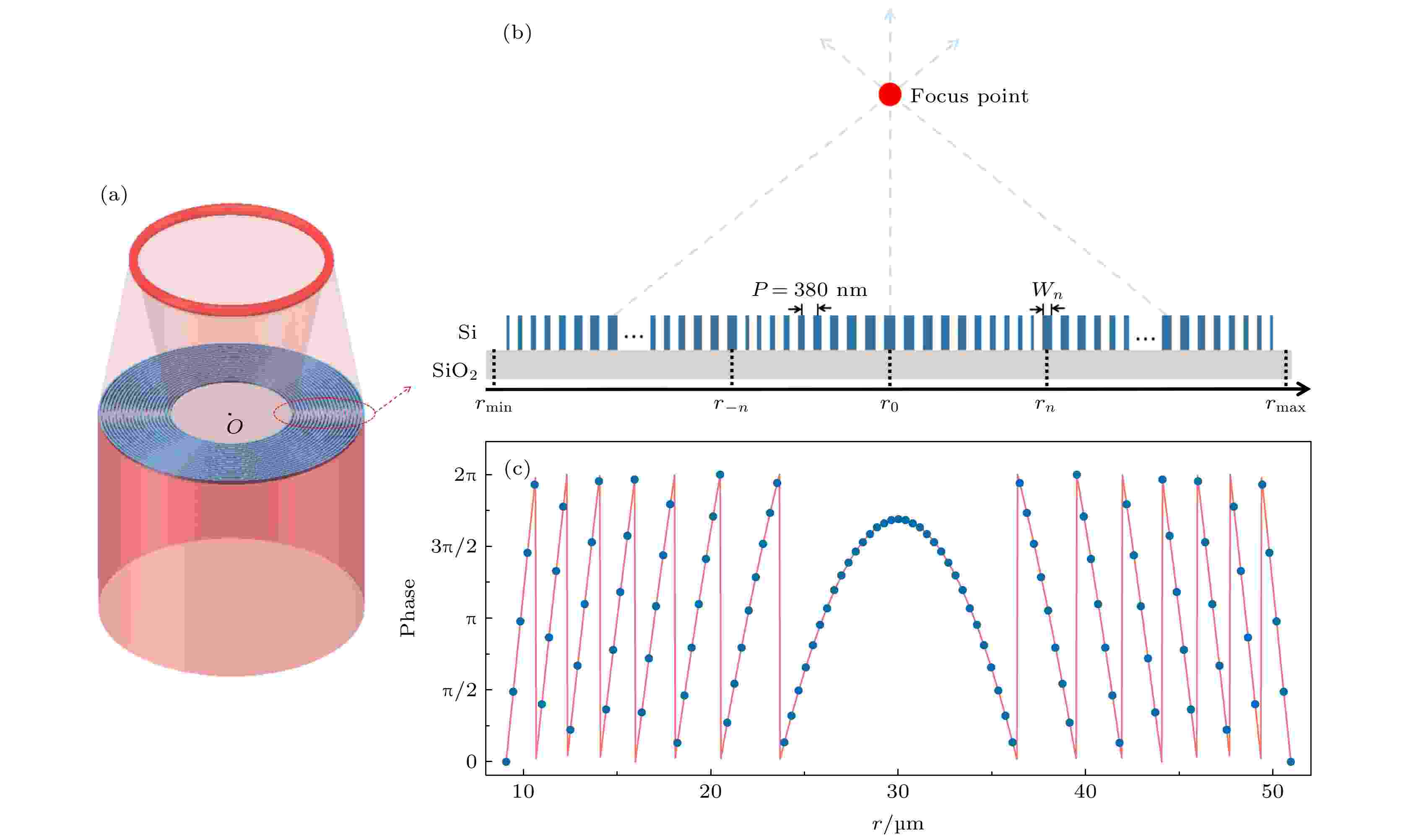 图 2 超表面环形透镜设计原理图 (a)超表面环形光场形成的原理图; (b)半径方向截面光栅排布结构示意图; (c)当焦距f = 22 μm时, 对应的相位分布图, 红色实线为所需相位曲线, 蓝色原点为单元结构实际所需的分立相位值
图 2 超表面环形透镜设计原理图 (a)超表面环形光场形成的原理图; (b)半径方向截面光栅排布结构示意图; (c)当焦距f = 22 μm时, 对应的相位分布图, 红色实线为所需相位曲线, 蓝色原点为单元结构实际所需的分立相位值Figure2. Design principle diagram of the metasurface ring lens: (a) Principle diagram of the formation of the ring light field; (b) layout structure diagram of the cross section of the half grating; (c) corresponding phase distribution for f = 22 μm, the red solid line is the required phase curve, and the blue dot is the discrete phase value required by the unit structure.
图2(b)是半径方向的光栅截面示意图, 为了会聚这个方向上的入射光, 通过光栅阵列表面的透射光相移需要满足凸透镜相位分布方程. 设计的光栅阵列由111个单元构成, 除中心单元外左右各55个单元对称分布, 单元结构中心位置坐标和对应每个单元结构需要对应的相位大小需要满足的公式如下:









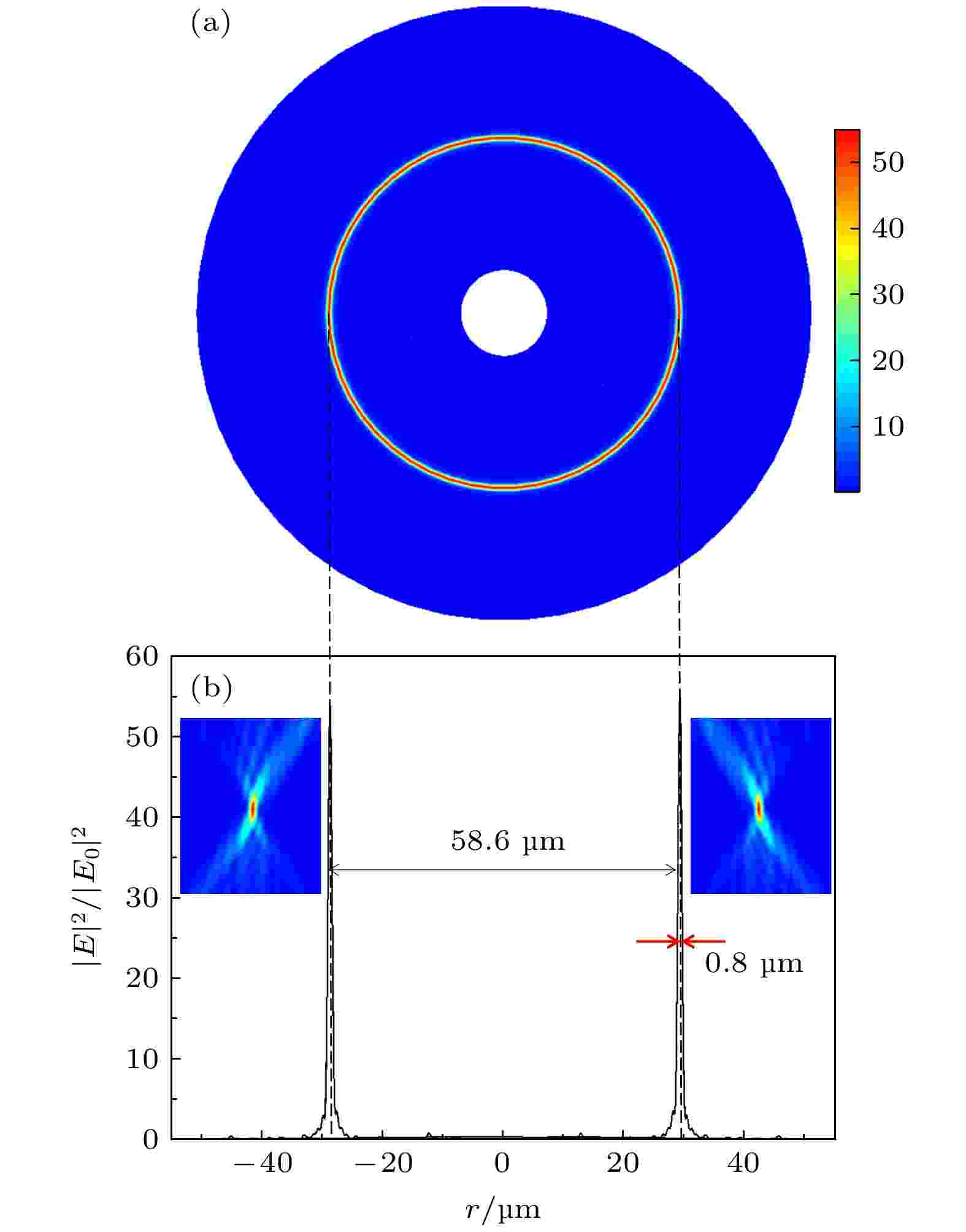 图 3 超表面环形光场的光强分布 (a)焦平面上二维光强度分布; (b)焦平面上一维光强度分布
图 3 超表面环形光场的光强分布 (a)焦平面上二维光强度分布; (b)焦平面上一维光强度分布Figure3. Intensity distribution of ring light field on the metasurface: (a) Two-dimensional intensity distribution on focal plane; (b) one-dimensional intensity distribution on focal plane.
接下来讨论具有不同数值孔径(NA)的超表面环形透镜的聚焦特性. 根据2.2节的方法设计了多种数值孔径的超表面环形透镜的结构. 当芯片宽度Rw = 42 μm, 把焦距设计半径f由34 μm变化到6 μm, 对应的数值孔径NA由0.52变化到0.96. 不同数值孔径时焦平面上相对光强最大值如图4所示. 图4中的插图为对应点的二维光强分布图. 当f = 34 μm, 即NA = 0.52时, 焦点位置最大相对光强|E|2/|E0|2 = 46.8, 二维光强分布图最长和最短半高全宽大小为(6.2 μm, 0.8 μm). 当f = 13 μm, 即NA = 0.85时, 相对光强|E|2/|E0|2 = 56.2, 对应的光强度图最长和最短半高全宽为 (2.0 μm, 0.8 μm). 当NA增大逐渐要突破衍射极限, 光强也开始慢慢减弱, 当f = 6 μm, 即NA = 0.96时, 相对光强|E|2/|E0|2 = 33.4, 对应的光强度图最长和最短半高全宽为1.37 μm和0.8 μm. 可以看出, 焦平面聚焦光环的最大光强度的大小随着超透镜焦距的减小出现先增大然后再变小的趋势; 而且焦平面上光斑的水平方向的尺寸不随数值孔径的改变而发生变化, 竖直方向的尺寸随着数值空间的增大而减小.
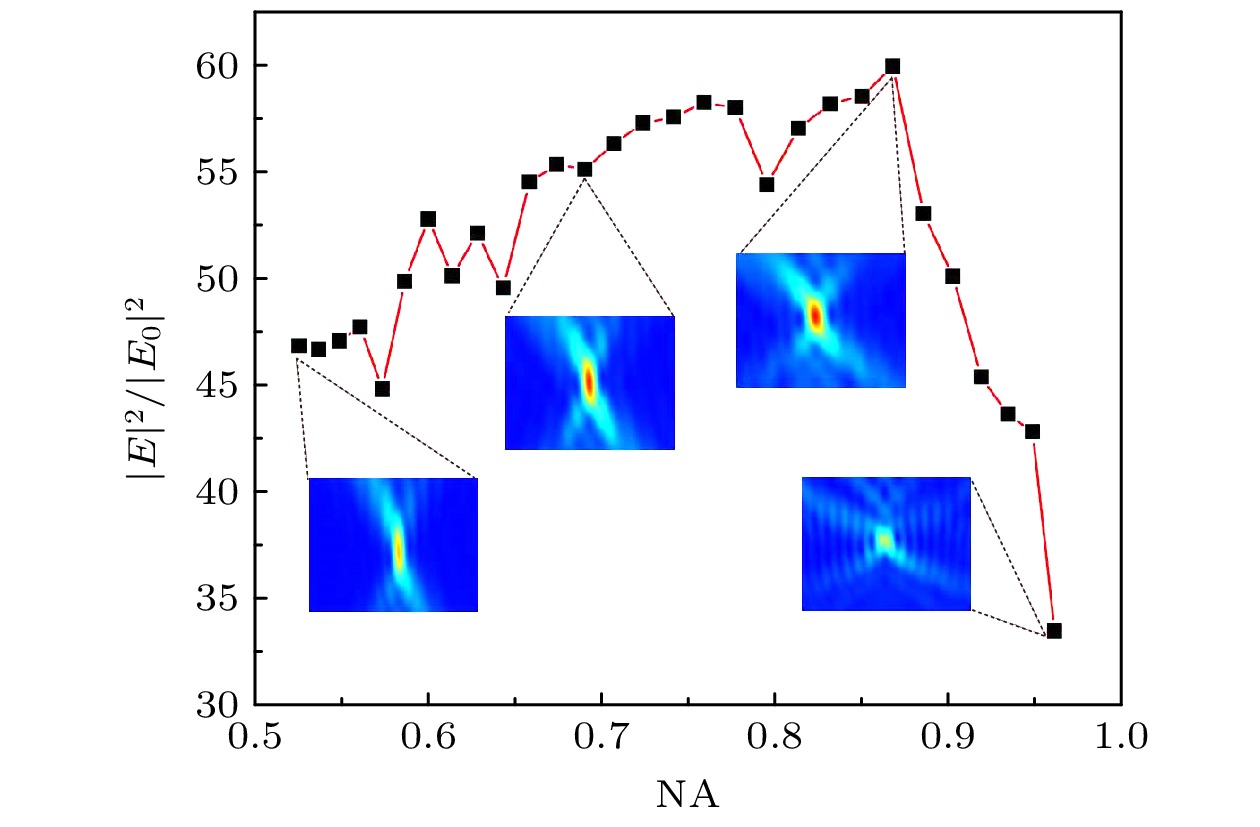 图 4 数值孔径NA对焦平面上聚焦光环的最大光强的影响
图 4 数值孔径NA对焦平面上聚焦光环的最大光强的影响Figure4. Effect of numerical aperture NA on the maximum intensity of the ring light field on the focal plane.
当中性分子在激光场中受到交流Stark效应时, 受到交流电磁场和光学偶极力的相互作用, 其相互作用势为[23]


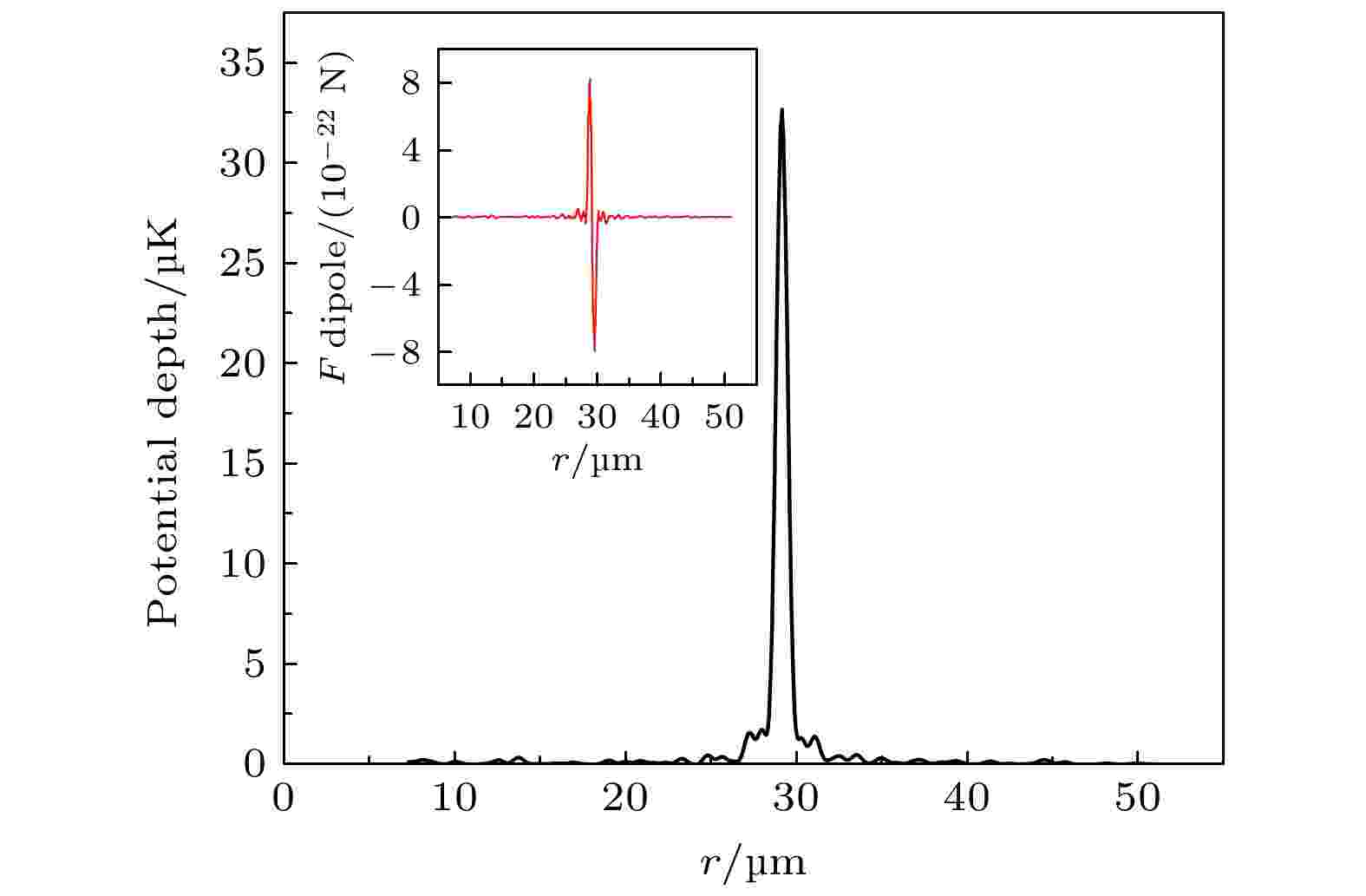 图 5 MgF分子在环形聚焦光场中所受光学势和偶极力(见插图)
图 5 MgF分子在环形聚焦光场中所受光学势和偶极力(见插图)Figure5. Optical potential and dipole force(inset firure) of MgF molecule in ring focused light field.
储存环也是一种环形光学势阱, 然而, 它并不是在空间上一点有最大囚禁势能, 而是在一个圆环上势能都一样大. 分子可以装在这种环形的光学势阱中, 也就是分子的存储环. 为了验证设计的光学储存环的囚禁效果, 我们进行了MgF分子三维Monte-Carlo动力学过程的模拟. 模拟的条件如下: MgF分子束切向呈高斯速度分布, 中心速度为0.2 m/s, 在10 μK玻尔兹曼速度分布之内, 沿储存环切向入射[27,28]. 观测区域为光环上MgF分子束入射点相对180°的小区域. 在储存环上一个很小的区域内考察分子数目随时间演化的关系, 也就是探测区域内分子数目随时间演化的关系, 结果如图6所示. 从图6可以看到, 分子波包在开始时纵坐标峰值为4.3 × 104个, 波包大约1 ms经过一次观测区域, 波包高度逐渐变矮, 在做圆周运动过程中分子波包不断拉长, 大约在5 ms后, 探测区域分子数目趋于稳定, 约为4 × 103, 表明了分子已经扩散到了整个光学储存环空间中. 探测区域内分子数随时间越来越少, 这是因为分子波包具有一定的速度展宽, 在做圆周运动过程中分子波包不断拉长, 最终稀释到整个储存环区域. 图7为单个氟化镁分子在储存环中运动轨迹的三维立体图, 分子在z方向的运动在焦平面附近0.25 μm的范围内; 红色虚线为在xoy平面的运动轨迹投影, 分子在r方向上运动在光束半径附近0.37 μm的范围内.
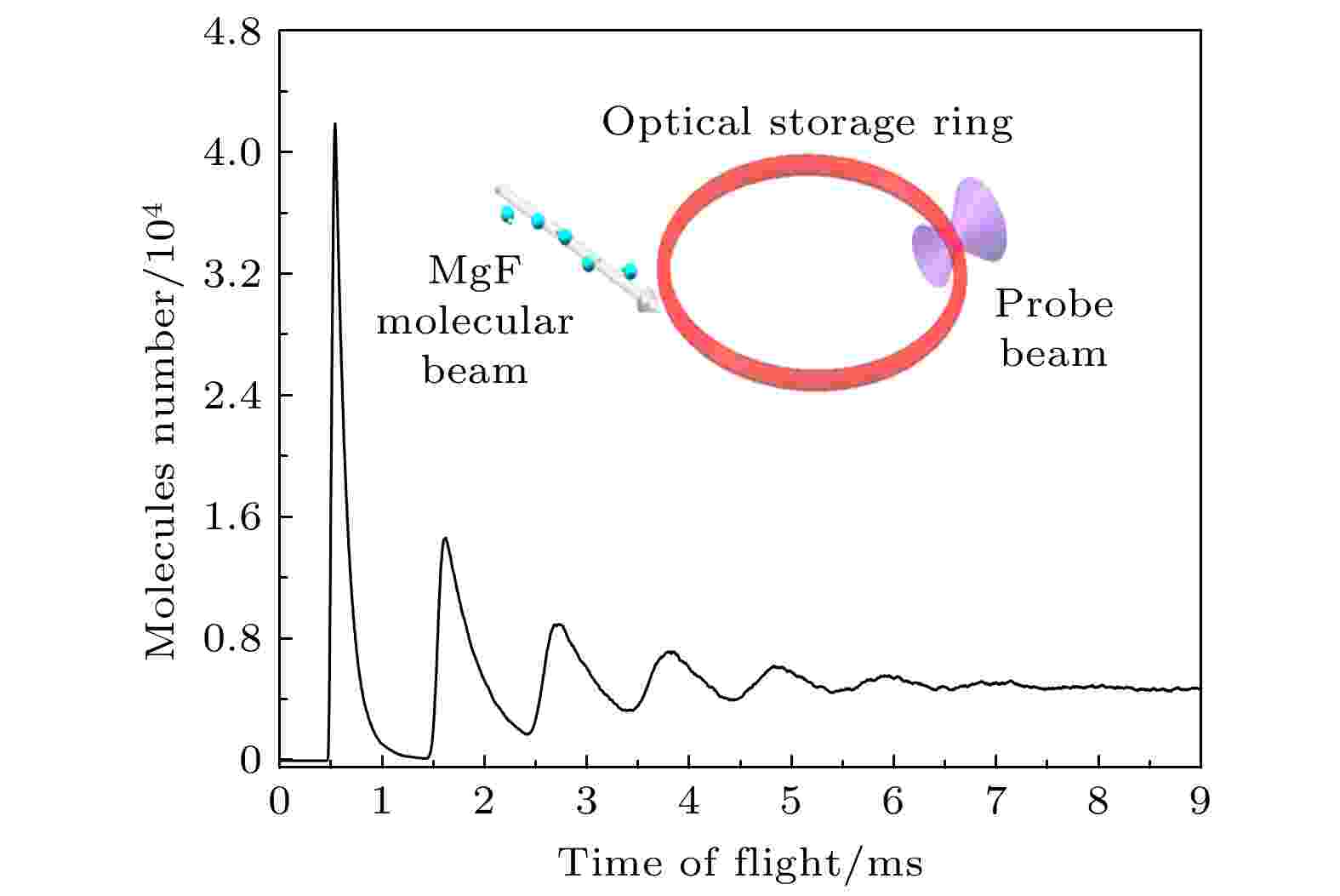 图 6 MgF分子束在存储环运动若干圈的飞行时间谱. 插图是探测原理示意图
图 6 MgF分子束在存储环运动若干圈的飞行时间谱. 插图是探测原理示意图Figure6. Time-of-flight spectrum of MgF molecular beam moving in the storage ring for several cycles. The illustration is the schematic diagram of molecule detection.
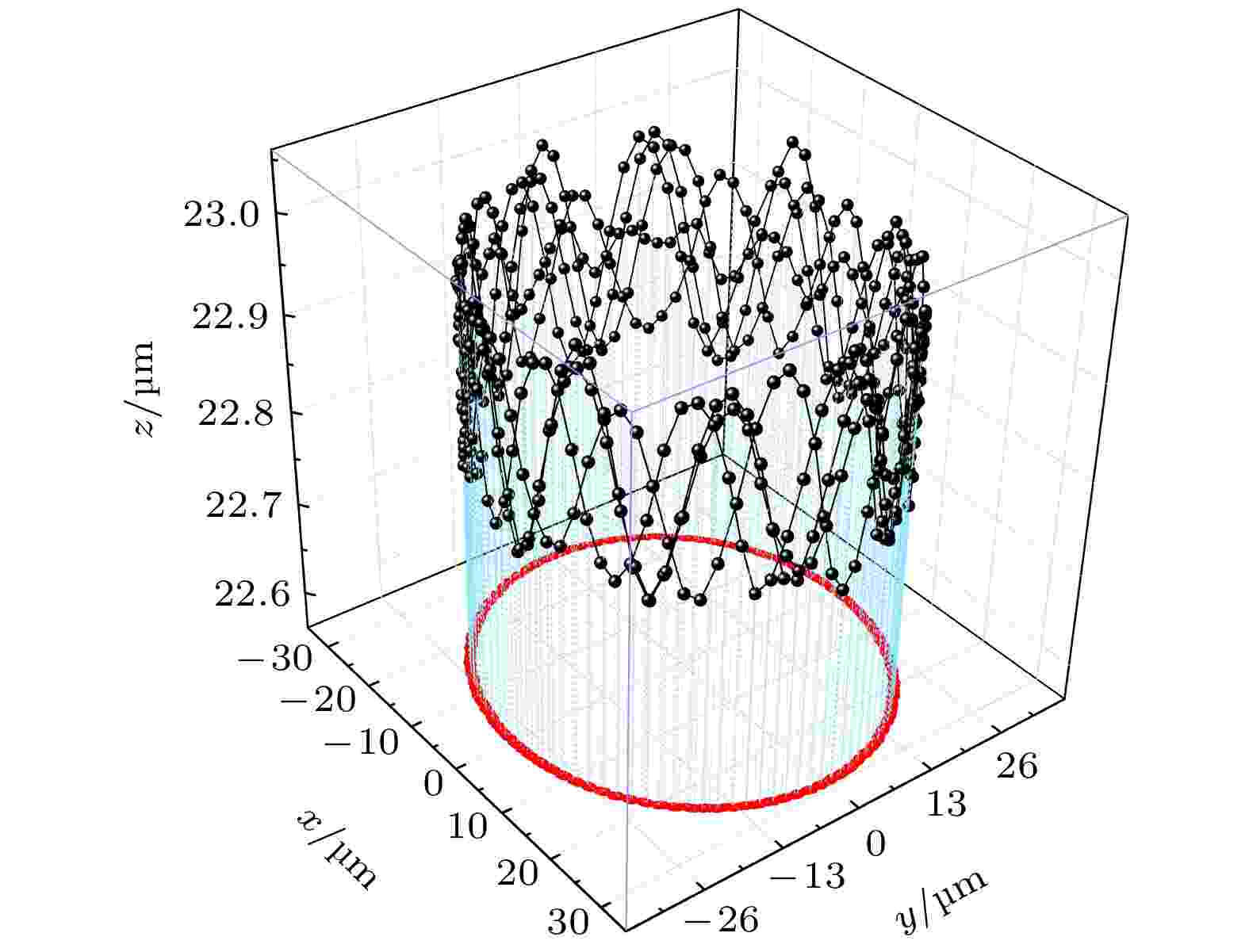 图 7 单个MgF分子在表面储存环中运动运动轨迹图, 其中红色虚线为分子在储存环中运动的俯视图, 也就是运动轨迹在xoy平面的投影
图 7 单个MgF分子在表面储存环中运动运动轨迹图, 其中红色虚线为分子在储存环中运动的俯视图, 也就是运动轨迹在xoy平面的投影Figure7. Motion trajectory of a single MgF molecule in the surface storage ring, in which the red dotted line is the top view of the motion of the molecule in the storage ring, that is, the projection of the motion trajectory on the xoy plane.
